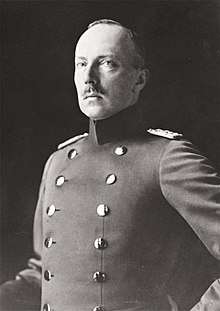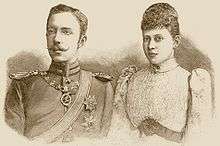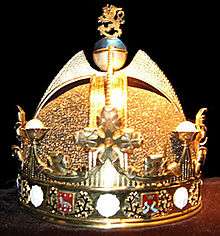Prince Frederick Charles of Hesse
Frederick Charles Louis Constantine, Prince and Landgrave of Hesse (German: Friedrich Karl Ludwig Konstantin Prinz und Landgraf von Hessen-Kassel; Finnish: Fredrik Kaarle; 1 May 1868 – 28 May 1940), was the brother-in-law of the German Emperor Wilhelm II. He was elected King of Finland on 9 October 1918, but renounced the throne on 14 December 1918. During his brief reign he was known in Finnish as Frederik Kaarle, King of Finland.
| Frederick Charles | |||||
|---|---|---|---|---|---|
 | |||||
| King-elect of Finland | |||||
| Reign | 9 October 1918 – 14 December 1918 | ||||
| Successor | Kaarlo Juho Ståhlberg (as President) | ||||
| Regent | P. E. Svinhufvud C. G. E. Mannerheim | ||||
| Born | 1 May 1868 Gut Panker, Plön, Kingdom of Prussia | ||||
| Died | 28 May 1940 (aged 72) Kassel, Nazi Germany | ||||
| Burial | Schloss Friedrichshof, Kronberg im Taunus, Germany | ||||
| Spouse | |||||
| Issue | Prince Friedrich Wilhelm Prince Maximilian Philipp, Landgrave of Hesse Prince Wolfgang Prince Christoph Prince Richard | ||||
| |||||
| House | Hesse-Kassel | ||||
| Father | Frederick William, Landgrave of Hesse | ||||
| Mother | Princess Anna of Prussia | ||||
| Religion | Lutheran | ||||
Early life and marriage
Frederick was born at his family's manor, Gut Panker, in Plön, Holstein. He was the third son of Frederick William of Hesse, Landgrave of Hesse, and his second wife Princess Anna of Prussia, daughter of Prince Charles of Prussia and Princess Marie Louise of Saxe-Weimar-Eisenach. Frederick William, a Danish military officer, had been one (and perhaps the foremost) of the candidates of Christian VIII of Denmark in the 1840s to succeed to the Danish throne if the latter's male line died out, but renounced his rights to the throne in 1851 in favor of his sister, Louise. Frederick William was of practically Danish upbringing, having lived all his life in Denmark, but in 1875, when the senior branch of Hesse-Kassel became extinct, he settled in northern Germany, where the House had substantial landholdings.

On 25 January 1893, Frederick Charles married Princess Margaret of Prussia, youngest sister of Kaiser Wilhelm II and a granddaughter of Queen Victoria of Great Britain. They had six children, all sons, including two sets of twins:
- Friedrich Wilhelm Sigismund Viktor (23 November 1893 – 12 September 1916), died in World War I, during the Dobrujan campaign
- Maximilian Friedrich Wilhelm Georg (20 October 1894 – 13 October 1914), died in World War I
- Philipp (1896–1980), twin with his brother Wolfgang; married Princess Mafalda of Savoy (1902–1944, Buchenwald), daughter of King Victor Emmanuel III of Italy and had issue.
- Wolfgang Moritz (1896–1989), twin with his brother Philipp. He married Princess Marie Alexandra of Baden, no issue
- Prince Christoph Ernst August of Hesse (1901–1943), twin with his brother Richard. An SS officer who died in active service during World War II, he married Princess Sophie of Greece and Denmark (sister of Prince Philip) and had issue.
- Richard Wilhelm Leopold (1901–1969), twin with his brother Christoph; unmarried
Upon their father's death in 1884, Frederick's eldest brother Frederick William became the head of the House of Hesse, and afterwards his next brother Alexander.
The Finnish throne

Frederick Charles was elected the King of Finland by the Parliament of Finland on 9 October 1918. However, with the end of World War I, in light of his German birth and the abdication of Emperor Wilhelm II of Germany ending monarchies in Germany, the arrangement was quickly considered untenable by influential Finns of the time and by Frederick himself. Not much is known of the official stance of the victorious Allied Powers. Frederick Charles renounced the throne on 14 December 1918, without ever arriving in the country, much less taking up his position. Finland then adopted a republican constitution.
Later life
Landgrave Alexander Frederick of Hesse abdicated as the head of the House of Hesse on 16 March 1925, and was succeeded by Frederick Charles, his younger brother.
At Frederick's death, his eldest surviving son, Philipp, succeeded him as head.
However, according to certain family documents and correspondence, his successor as King of Finland would have been his second surviving son Prince Wolfgang of Hesse (1896–1989), apparently because Wolfgang was with his parents in 1918 and ready to travel to Finland, where a wedding to a Finnish lady was already in preparation for the coming Crown Prince. Philipp was in the military and unable to be contacted at the time. This choice of the younger of the twins, however, was not intended to mean that in future generations, the kingship would have been passed on through secundogeniture, with the eldest son always succeeding to the Hesse title (according to Dr. Vesa Vares). On the contrary, it is practically inconceivable that succession of a kingdom would depend on secondary consideration. The source Viini 2/2007 (in Finnish) indicates a view that until his death Moritz of Hesse was the current successor, and prince Donatus was the heir.
Titles, styles and honours
Titles and styles
- 1 May 1868 – 13 October 1888: His Highness Prince Frederick Charles of Hesse
- 14 October 1888 – 15 March 1925: His Royal Highness The Hereditary Prince of Hesse
- 9 October 1918 – 14 December 1918: His Majesty The King of Finland and Karelia, Duke of Åland, Grand Duke of Lapland, Lord of Kaleva and the North
- 15 December 1918 – 15 March 1925: His Royal Highness The Hereditary Prince of Hesse
- 16 March 1925 – 28 May 1940: His Royal Highness The Landgrave of Hesse
Honours

.svg.png)

.svg.png)
- Knight of the Order of the Black Eagle[3]
- Knight Grand Cross of the Order of the Red Eagle
.svg.png)

Ancestry
| Ancestors of Prince Frederick Charles of Hesse | |||||||||||||||||||||||||||||||||||||||||||||||||||||||||||||||||||||||||||||||||||||||||||||||||||||||||||||||||||||||||||||||||||||||||||||||||||||||||||||||||||||||||||||||||||||||||||||||||||||||||||||||||||||||||||||||||||||||||||||||||||||||||||||||||||||||||||||||||||||||||
|---|---|---|---|---|---|---|---|---|---|---|---|---|---|---|---|---|---|---|---|---|---|---|---|---|---|---|---|---|---|---|---|---|---|---|---|---|---|---|---|---|---|---|---|---|---|---|---|---|---|---|---|---|---|---|---|---|---|---|---|---|---|---|---|---|---|---|---|---|---|---|---|---|---|---|---|---|---|---|---|---|---|---|---|---|---|---|---|---|---|---|---|---|---|---|---|---|---|---|---|---|---|---|---|---|---|---|---|---|---|---|---|---|---|---|---|---|---|---|---|---|---|---|---|---|---|---|---|---|---|---|---|---|---|---|---|---|---|---|---|---|---|---|---|---|---|---|---|---|---|---|---|---|---|---|---|---|---|---|---|---|---|---|---|---|---|---|---|---|---|---|---|---|---|---|---|---|---|---|---|---|---|---|---|---|---|---|---|---|---|---|---|---|---|---|---|---|---|---|---|---|---|---|---|---|---|---|---|---|---|---|---|---|---|---|---|---|---|---|---|---|---|---|---|---|---|---|---|---|---|---|---|---|---|---|---|---|---|---|---|---|---|---|---|---|---|---|---|---|---|---|---|---|---|---|---|---|---|---|---|---|---|---|---|---|---|---|---|---|---|---|---|---|---|---|---|---|---|---|---|---|---|
| |||||||||||||||||||||||||||||||||||||||||||||||||||||||||||||||||||||||||||||||||||||||||||||||||||||||||||||||||||||||||||||||||||||||||||||||||||||||||||||||||||||||||||||||||||||||||||||||||||||||||||||||||||||||||||||||||||||||||||||||||||||||||||||||||||||||||||||||||||||||||
References
- Hof- und Staats-Handbuch für des Herzogtum Anhalt (1894), "Herzoglicher Haus-Orden Albrecht des Bären" p. 17
- Hof- und Staats-Handbuch des Großherzogtum Baden (1910), "Großherzogliche Orden" p. 41
- Justus Perthes, Almanach de Gotha 1913 (1913) pages 44
- Jørgen Pedersen (2009). Riddere af Elefantordenen, 1559–2009 (in Danish). Syddansk Universitetsforlag. p. 465. ISBN 978-87-7674-434-2.
- Staatshandbuch für das Großherzogtum Sachsen / Sachsen-Weimar-Eisenach (1900), "Großherzogliche Hausorden" p. 17
- Shaw, Wm. A. (1906) The Knights of England, I, London, p. 212
- Large article on Helsingin Sanomat newspaper about Friedrich Karl and his descendants, including the current "pretender" for the throne.
- Nash, Michael L (2012) The last King of Finland. Royalty Digest Quarterly, 2012 : 1
See also
- List of Finnish monarchs
- Rulers of Hesse
- Archduke Charles Stephen of Austria
- Mindaugas II of Lithuania
External links
| Wikimedia Commons has media related to Prince Frederick Charles of Hesse. |
Prince Frederick Charles of Hesse House of Hesse-Kassel Born: 1 May 1868 Died: 28 May 1940 | ||
| Regnal titles | ||
|---|---|---|
| Preceded by Alexander Frederick |
Head of the House of Hesse | Succeeded by Landgraf Philipp |
| Titles in pretence | ||
| Kingdom abolished | — TITULAR — King of Finland and Karelia 14 December 1918 – 28 May 1940 Reason for succession failure: Kingdom abolished in 1918 |
Succeeded by Philipp |
| Preceded by Alexander Frederick |
— TITULAR — Elector of Hesse | |